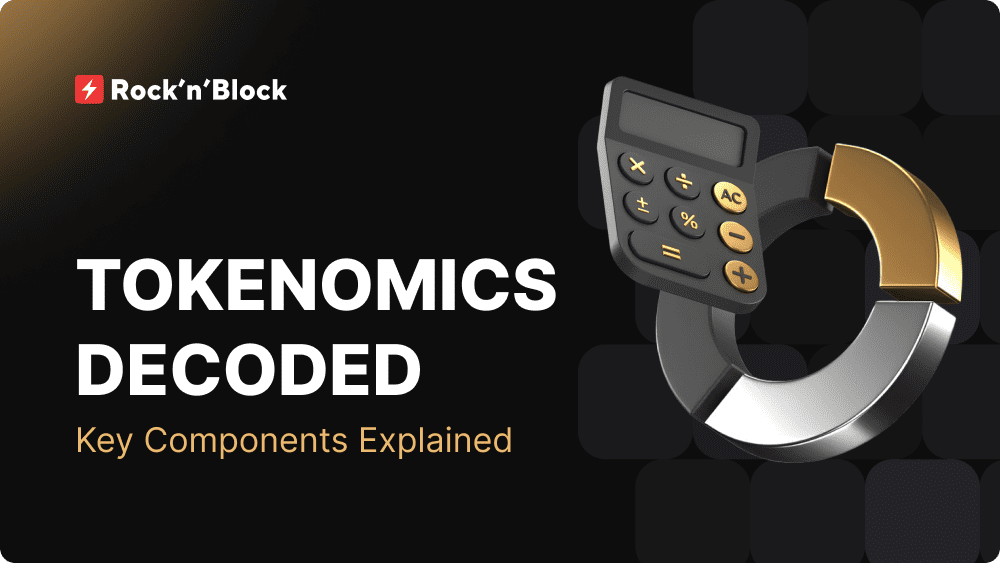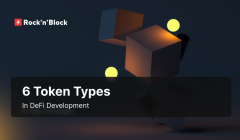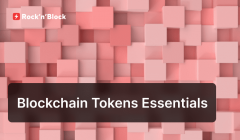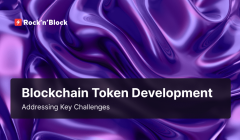Tokenomics Decoded: Key Components Explained
03 May 2024Understanding tokenomics is essential for anyone involved in DeFi and crypto token development. Tokenomics serves as the economic blueprint that governs cryptocurrency tokens within decentralized ecosystems.
This guide explains the basics of tokenomics, including its importance and key components. It aims to help you confidently navigate the complexities of tokenomics. Join us as we explore the mysteries of tokenomics and its role in driving innovation and shaping the future of finance in the digital age.

Table of Contents:
-
What Is Tokenomics?
-
Why Is Tokenomics Important For Your Project?
-
Key Components of Tokenomics
-
Token Supply
-
Token Distribution and Allocation
-
Vesting Schedules and Lock-up Periods
-
Token Utility
-
Token Demand Mechanisms
-
Common Pitfalls in Tokenomics
-
Is It Hard to Create Tokenomics?
What Is Tokenomics?
Tokenomics is the combination of the words 'token' and 'economics'. It refers to the economic principles that govern the creation, distribution, and management of cryptocurrency tokens, as well as the organization of all related processes. It includes factors such as token supply, utility, distribution mechanisms, and the overall economic model underlying a particular cryptocurrency project.
In simpler terms, tokenomics outlines the rules and incentives that govern how a crypto token functions within its ecosystem. It covers everything from how the token is made and handed out to how it's used in decentralized systems, often with the help of blockchain technology.
Why Is Tokenomics Important For Your Project?
Tokenomics is essential for the success and sustainability of cryptocurrency projects. It provides a structured framework for the token development process within an ecosystem. It provides a structured framework for the token creation, distribution, and utilization within the token’s ecosystem.
Tokenomics is especially crucial for projects focused on DApp development, launching ICOs, or creating DeFi protocols. Tokenomics is the economic foundation of these projects. It incentivizes community participation, ensures token utility and value, and establishes governance mechanisms for decision-making.
Tokenomics is essential for projects seeking to build vibrant and sustainable decentralized ecosystems.
Why Tokenomics Matter
If you are interested in crypto token development, a deep understanding of tokenomics’ benefits is essential to create a successful DeFi project.
- Economic Model Design: Tokenomics define the economic model of a crypto project. Designing an effective tokenomics model is essential for creating a sustainable and robust ecosystem that incentivizes desired behaviors, fosters growth, and aligns the interests of stakeholders.
- Token Value and Utility: Tokenomics play a significant role in determining the value and utility of a project's native token. A well-designed tokenomics model can create demand for the token by providing clear use cases, incentives, and benefits for holding and using the token within the ecosystem. This, in turn, can contribute to the token's liquidity, market capitalization, and overall attractiveness to investors and users.
- Funding and Capital Formation: Tokenomics often serve as the basis for fundraising and capital formation in crypto projects. A well-structured tokenomics model can attract investment and support blockchain project development and growth.
- Community Building: Tokenomics provides mechanisms for building and nurturing communities around the project, fostering loyalty, collaboration, and support among users and contributors.
- Sustainability: Robust tokenomics development ensures the long-term sustainability of the project by creating economic structures that support ongoing development, maintenance, and growth.
- Market Competitiveness: Projects with well-designed tokenomics gain a competitive edge by offering attractive incentives and clear value propositions, positioning themselves as leaders in the market.
Key Components of Tokenomics
Understanding the fundamentals of tokenomics is essential for grasping the intricacies of token economy. Let’s explore the key components of tokenomics that lay the foundation for crypto token development and ecosystem management.
Token Supply
In crypto token development token supply refers to the total quantity of tokens that will ever be generated within a cryptocurrency ecosystem. It is a fundamental aspect of tokenomics that determines the availability and scarcity of tokens within the network. Project owners and stakeholders must understand token supply dynamics as it affects token economics, including valuation, inflationary or deflationary pressures, and long-term sustainability.
Examples of token supply mechanisms in cryptocurrency projects vary depending on the project's goals and economic model. Here are some examples:
-
Fixed Supply: Some projects opt for a fixed token supply, meaning that the total number of tokens in existence is predetermined and cannot be changed. Bitcoin (BTC) is a prominent example of a cryptocurrency with a fixed supply of 21 million coins. This model promotes scarcity and may lead to increased token value over time due to limited availability.
-
Inflationary Supply: Other projects implement an inflationary token supply model, where new tokens are continuously issued over time. For instance, Ethereum (ETH) currently has no fixed supply cap, and new tokens are issued as block rewards to miners. Inflationary supply models aim to incentivize network participation and ensure ongoing security and network maintenance.
-
Deflationary Supply: In contrast to inflationary models, some projects choose deflationary tokenomics, where the token supply decreases over time. This can be achieved through mechanisms such as token burns. Token burns are commonly executed through smart contract development. This involves sending a specified quantity of tokens to an inaccessible address, effectively removing them from circulation. Token burns can enhance token scarcity, incentivize holding, and potentially drive up demand and value. Binance Coin (BNB) periodically burns a portion of its supply, reducing the total token supply and potentially increasing token value due to increased scarcity.
-
Algorithmic Supply: Certain projects use algorithms to regulate token supply based on predetermined rules. Ampleforth (AMPL) is an example of such a project, adjusting its token supply daily to maintain a stable purchasing power. The goal of algorithmic supply models is to achieve price stability and reduce volatility.
These examples demonstrate the diversity of token supply mechanisms employed by cryptocurrency projects, each tailored to achieve specific economic goals and incentivize desired behaviors within their respective ecosystems.
Token Distribution and Allocation
The token distribution and allocation establish the economic model for the DeFi project development. This includes deciding the initial number of tokens and how they will be distributed among stakeholders, such as team, investors, advisors, and the community. It also determines the distribution of tokens for different purposes, such as staking rewards, yield farming rewards, airdrops, marketing initiatives, strategic partnerships and so on.
These are just a few examples of token allocation tranches, and projects may incorporate other token distribution practices based on their objectives and economic models.
Vesting Schedules and Lock-up Periods
To prevent token dumping and promote long-term commitment, projects may implement vesting schedules or lock-up periods for tokens allocated to team members, advisors, and early investors.
These mechanisms are designed to regulate the release of tokens to stakeholders over time, ensuring responsible token distribution and preventing market volatility.
Vesting schedules outline the timeline for releasing tokens to specific stakeholders. With token vesting development, projects incentivize long-term commitment and discourage immediate selling or dumping of tokens, thereby promoting price stability and project sustainability.
Lock-up periods complement vesting schedules by imposing restrictions on token transfers or sales during a specified timeframe. This prevents stakeholders from selling their tokens immediately after receiving them, thereby reducing the risk of token dumping and excessive market volatility. Lock-up periods are often applied to founders, team members, or early investors to align their interests with the long-term success of the project and discourage short-term speculation.
Token Utility
Token utility refers to the functionality, use cases, and value proposition of a cryptocurrency token within its ecosystem that drive value and scarcity for the token. It encompasses the various ways in which tokens can be utilized, exchanged, and interacted with to access products, services, or governance rights.
Token utility is crucial as it directly impacts the demand for the token in the market. Without a clear utility model, the token is unlikely to be useful or valuable, emphasizing the importance of defining its role within the project's ecosystem.
Utility within Decentralized Applications
Tokens often serve as native currencies or utility tokens within decentralized applications, granting users access to platform features, services, or resources. Token utility can manifest in various forms, depending on the project's objectives and ecosystem. Here are some common types of token utility:
-
Access and Membership: Tokens can grant users access to specific features, services, or membership privileges within the project's platform or ecosystem.
-
Transaction Medium: Tokens can serve as a medium of exchange for conducting transactions within the ecosystem, such as buying goods, services, or digital assets.
-
Rewards and Incentives: Tokens can be used to incentivize desired behaviors or contributions within the ecosystem, such as providing liquidity, referring users, or participating in community activities.
-
Discounts and Benefits: Tokens can offer discounts, bonuses, or other benefits to users who hold or use them within the ecosystem, encouraging loyalty and engagement.
-
Gaming and Virtual Worlds: Tokens can serve as in-game currencies or assets within virtual worlds and gaming platforms, enabling players to purchase items, access content, or participate in virtual economies.
-
Content Creation and Curation: Tokens can incentivize users to create, curate, or contribute content within decentralized platforms, rewarding them for valuable contributions.
-
Data Access and Marketplace: Tokens can grant access to data or services within decentralized marketplaces, allowing users to buy, sell, or exchange data, information, or digital assets.
-
Governance and Voting Rights: Some tokens confer governance rights, allowing holders to participate in decision-making processes, such as protocol upgrades, parameter adjustments, or community governance initiatives. Token holders may vote on proposals, delegate voting power, or stake tokens to influence the direction and governance of the ecosystem.
These are just a few examples of token utility types, and projects may incorporate multiple utility mechanisms to enhance the value proposition of their tokens and incentivize user participation within their ecosystems.
Token Demand Mechanisms
Tokenomics goes beyond the token's supply system and must be in sync with a strong demand mechanism. Wrong demand mechanisms can weaken tokenomics over time.
Game Theory
Game Theory is an economic theory that guides rational decision making based on expected benefits, and it explains the market demand surrounding any token. Within blockchain, staking and yield farming development are examples of distinct elements of game theory. Traders participate by locking up their crypto assets to earn rewards, with longer lock-up durations resulting in greater gains.
Communal Vibrancy
Community vibrancy is also a crucial factor in token valuation, as it represents collective belief in the project's potential beyond game theory. Evaluating public mood on social platforms like Facebook and X provides insight into community engagement. Active participation in real-life innovations further strengthens community support. The underlying logic is simple: if the community perceives the token as valuable, its prospects are brighter.
Common Pitfalls in Tokenomics
Poor tokenomics is a significant indicator of project failure. Several factors contribute to bad tokenomics, serving as potential red flags for investors. Three key elements include:
Massive Pump and Dumps
Disproportionately allocating tokens to early investors, leading to massive pump and dumps during token pre-sales. This imbalance may result in pump and dump schemes, where early investors manipulate the token price to profit at the expense of newer investors. Therefore, it is crucial to scrutinize the token distribution before investing in any project.
Unlimited Supply
Although an unlimited token supply may not be problematic in itself, it should be justified in its implementation. Ethereum's unlimited supply aligns with its utility and solves various issues, ensuring ongoing market relevance. However, adopting an unlimited supply without valid reasoning can be indicative of poor tokenomics. Such a model may enable the founding team to mint tokens arbitrarily, profiting at the expense of investors once the token gains value.
Lack of Actual Utility
Without tangible purposes within the project's ecosystem, the token becomes a speculative asset vulnerable to market volatility and dwindling demand. Projects lacking genuine utility struggle to maintain sustained user engagement and fail to address real-world problems, hindering their credibility and sustainability in the competitive cryptocurrency landscape. In a market driven by utility and value, token without genuine utility struggles to attract long-term adoption and support, jeopardizing their success and longevity.
Is It Hard to Create Tokenomics?
Creating tokenomics can be a complex effort that requires a deep understanding of economic principles, market dynamics, and blockchain technology. Designing tokenomics that align with project goals, incentivize desired behaviors, and ensure long-term sustainability can be a challenging task. To effectively navigate these complexities, it is advisable to enlist the services of a robust and experienced tokenomics development company that specializes in blockchain and cryptocurrency solutions. These companies possess the expertise and resources to craft robust tokenomics models tailored to the unique requirements of each project. Businesses can streamline the tokenomics development process, mitigate risks, and ensure the viability of their cryptocurrency projects in the competitive market by leveraging their knowledge and experience.
We ❤️ Development
Follow us on social media to receive the hottest blockchain development updates
Twitter ⚡️Telegram⚡️LinkedIn⚡️Facebook










